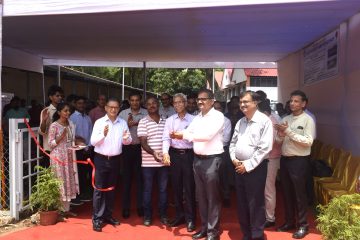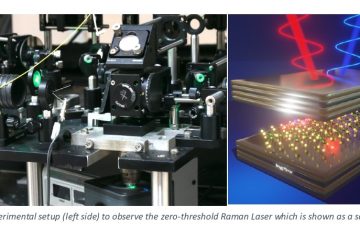 Professor Tony McNally, Director- International Institute for Nanocomposites Manufacturing; Director-National Polymer Processing Centre of WMG, was the Chief Guest at the International Conference on Advances in Polymer Science and Technology (APSRT) being held at IIT Kharagpur between September 24-27 by the Rubber Technology Centre of the Institute. He spoke to KGP Chronicle on the legacy of Lord Bhattacharyya and WMG’s long relationship with IIT Kharagpur.
Professor Tony McNally, Director- International Institute for Nanocomposites Manufacturing; Director-National Polymer Processing Centre of WMG, was the Chief Guest at the International Conference on Advances in Polymer Science and Technology (APSRT) being held at IIT Kharagpur between September 24-27 by the Rubber Technology Centre of the Institute. He spoke to KGP Chronicle on the legacy of Lord Bhattacharyya and WMG’s long relationship with IIT Kharagpur.
On Lord Bhattacharyya and WMG:

Lord Kumar Bhattacharyya was the Founder of the WMG in 1980 at a time when British industry was in dire straits and needed help. He was a man before his time. He was a visionary. He had the idea of merging academic excellence with industrial relevance so that the results of academic research could be translated quickly and, more importantly, industries could get the help of universities quickly. He had this idea at a time when many were not interested. So he approached the Vice-Chancellor of the University of Warwick. Lord Bhattacharyya, along with a secretary, started WMG and here we are 40 years later with 10 buildings, tens and millions of pounds in turnover, 300 PhD students, 300 post-doctoral researchers and about 2000 staff and internationally focussed units.
Over the decades, Lord Bhattacharyya built relations with industrial partners and leading companies. Most of the early successes were with Indian industry – Tata Motors for example. He was great friend of Ratan Tata and following from that success he started working with companies like TVS in India. But the key contribution he made in UK was that he brokered the purchase of Jaguar Land Rover by the Tata group, thereby creating thousands of jobs in the UK that are in existence today because of Lord Bhattacharyya’s contribution. That is a tremendous legacy to leave.
Eventually, Lord Bhattacharyya’s services came to be of great demand by other industries,other universities around the world and particularly by other governments. He ended up being advisor to many governments – South Africa for instance- over many years. The model that he adopted is being discussed in great detail by other countries, such as in Australia, which is looking very closely at this model of co-location of industry with an university department.

The other major contribution of Lord Bhattacharyya was in teaching, particularly teaching for industry. He set up many courses related to the needs of industry – supply chain, logistics, manufacturing systems engineering, engineering management and so on. As a consequence, today there are 13-14 different executive courses run by WMG which are very popular. The other model he introduced was designing bespoke engineering programs for companies. There are many people who work in companies who have not been able to go to universities for some reason. What he used to do is design programs from the scratch so that employees could attend university – one week per month they would study at the university and the other weeks of the month be with the company. This proved to be very popular. WMG has implemented this model while working with Jaguar, with Tyson Technology.
Overall, the contribution is immense in terms of the opportunities he gave people, like myself, also the model which is now being adopted across the world on how to transfer research to industry, how to train industry or transfer skillset that the industry really needs..
On WMG’s collaboration with IIT Kharagpur:

Lord Bhattacharyya was very proud of being an alumnus of IIT Kharagpur. I joined WMG six years ago, and since then have been witness to an integrated system of PhD programs, Masters and UG programs. Then there is also the UKRI (UK Research and Innovation) link with IITs, especially IIT Kharagpur, and there is a drive for collaboration to focus on global challenges like clean water, energy, sustainability, recycling and electrification of transport. And this is an area that IIT Kharagpur, WMG and Tata Group, especially Tata Motors are very much focussed on. As I speak, there is a delegation from IIT Kharagpur at WMG looking at the battery facility.
So the plan on electrification of vehicles is already moving and the reason why I accepted the invitation to come to the International conference on Polymer Science and Rubber Technology is that we wanted to do exactly the same kind of research with new materials, polymers and rubber technology, functionality, and intelligent materials. The Rubber Technology Centre at IIT Kharagpur is globally famous, long established, with its alumni spread all over the world, occupying top positions in universities and industry. Unfortunately, UK has not invested greatly in rubber technology in universities, so it makes sense to collaborate with the best.

WMG also has collaboration with IIT Kharagpur in autonomous vehicles. WMG is working on driverless cars and driverless transport. WMG is also an international partner of IIT Kharagpur’s Centre for Advanced Manufacturing. Also, we have students of IIT Kharagpur come over WMG for internships and Masters. This has been historically in the case of Metallurgy but now we are looking at Joint PhDs as well.
On carrying forward Lord Bhattacharyya’s legacy:
Lord Bhattacharyya’s shoes are very difficult to fill because he was unique. It would be a silly thing to even try to do that. We will carry on as usual. But there is, I believe, a vast influence missing. As a university we will try to get another person of similar standing who had influence in the government, around the world, and in industry and try to possibly continue with the legacy. The groundwork is set and the foundations are strong. Lord Bhattacharyya used to meet professors every month and his favourite phrase during that time was ‘consolidate’. Nobody could stand still and his directive was “go, go”, “build, build”. If you hear that once a month it becomes instilled in you. So that mentality is there. In that sense, we will continue to build on the foundations. But we need someone as influential as Lord Bhattacharyaa so that we can have that kind of presence globally.
Banner and Pics of Prof. McNally: Suman Sutradhar



